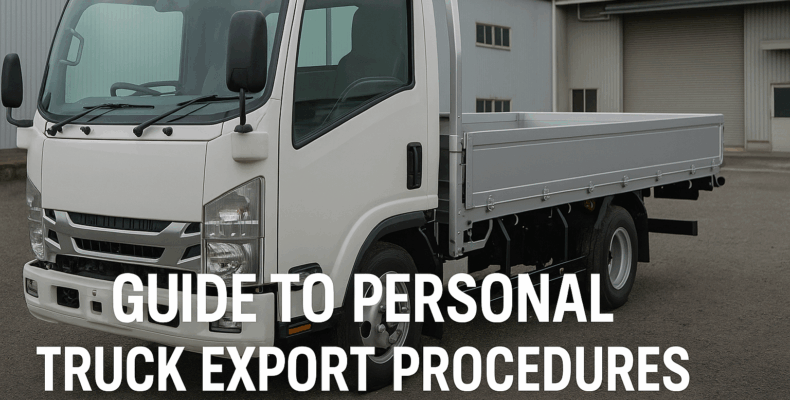Guide to Personal Truck Export Procedures
So, you’ve found the perfect used truck in Japan and want to export it yourself. That’s great! However, exporting a truck involves more than just picking a vehicle and booking a ship. You must follow a step-by-step process, handle documentation, and comply with both Japanese laws and overseas import regulations.
This guide breaks it all down in simple terms—so you can export like a pro, even if it’s your first time.
Before you start, consider working with experienced partners. Here’s a helpful list of
👉 Top 5 Trusted Japanese Used Truck Exporters for Global Buyers
Step 1: Buy the Truck and Complete Ownership Transfer
First, you need to:
-
Choose your truck through an auction, dealer, or private seller
-
Finalize the purchase
-
Complete the de-registration process with the Japan Ministry of Land, Infrastructure, Transport, and Tourism (MLIT)
You’ll receive a de-registration certificate (also called “Export Certificate”), which is needed for customs and shipping.
Tip: Use your real name and address for all official paperwork.
Step 2: Get a Pre-Export Inspection (If Required)
Many countries require a roadworthiness inspection before the truck is shipped. For example:
-
JEVIC (Japan Export Vehicle Inspection Center)
-
QISJ (Quality Inspection Services Japan)
-
JAAI (Japan Auto Appraisal Institute)
These inspections verify that the truck meets the import standards of countries like Kenya, Uganda, New Zealand, and Tanzania.
Important: Schedule this inspection early to avoid port delays.
Step 3: Prepare the Export Documents
Here’s what you’ll need:
| Document | Purpose |
|---|---|
| Export Certificate | Confirms ownership and de-registration |
| Commercial Invoice | Lists truck value and buyer information |
| Bill of Lading (B/L) | Shipping document from the freight company |
| Inspection Certificate | For countries with pre-shipment inspection |
| Shipping Instructions | Contains delivery and contact details |
Make several copies of each document for customs and registration authorities.
Step 4: Choose a Shipping Method
There are two main shipping options:
🔄 RoRo (Roll-on/Roll-off)
-
Cheaper
-
Suitable for drivable trucks
-
No container required
📦 Container Shipping
-
More secure
-
Ideal for small trucks or multiple items
-
Higher cost
For most used trucks, RoRo is the preferred choice due to lower handling fees and faster loading times.
Step 5: Book Shipping and Clear Customs
Work with a freight forwarder or shipping company that can:
-
Book space on a RoRo vessel
-
Handle Japanese customs export clearance
-
Arrange inland transport to the port (if needed)
Customs agents may ask for:
-
Truck photographs
-
Engine and chassis numbers
-
Document scans
Ensure everything is ready before shipping deadlines.
Step 6: Track Shipment and Receive the Truck Abroad
After departure, your freight company will provide a Bill of Lading (B/L) and tracking details.
When the truck arrives in your country:
-
Present your documents at the port
-
Pay applicable import duties and taxes
-
Complete vehicle registration locally
Congratulations—you’ve successfully exported your Japanese truck!
Common Mistakes to Avoid
-
Missing inspections: Your truck might be refused entry.
-
Incorrect paperwork: Customs will delay or reject clearance.
-
Choosing the wrong truck: Size or age restrictions exist in some countries.
-
Underestimating costs: Don’t forget taxes, duties, and inland transport fees.
-
Ignoring trusted exporters: Doing it alone is risky—get help when needed.
That’s why we recommend exploring this helpful list:
👉 Top 5 Trusted Japanese Used Truck Exporters for Global Buyers
Why Export a Japanese Truck Yourself?
-
Cost control: No middleman fees
-
Learning experience: Gain knowledge for future exports
-
Flexibility: Choose your timeline and destination
However, the process requires attention to detail and good planning. If you need support, even experienced exporters offer hybrid services where you control the buying, and they handle the shipping.
Final Thoughts: Export with Confidence
Exporting your own truck from Japan is absolutely possible. With the right steps, clear documents, and trustworthy shipping support, you’ll get your vehicle delivered legally and safely.
For smoother results, start with professionals who understand every part of the process.
👉 Top 5 Trusted Japanese Used Truck Exporters for Global Buyers
